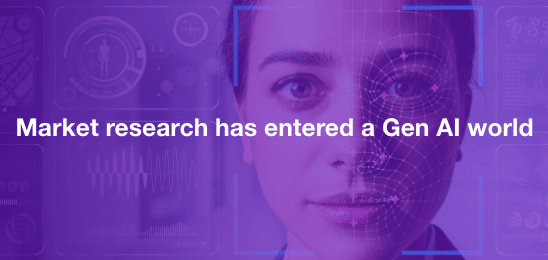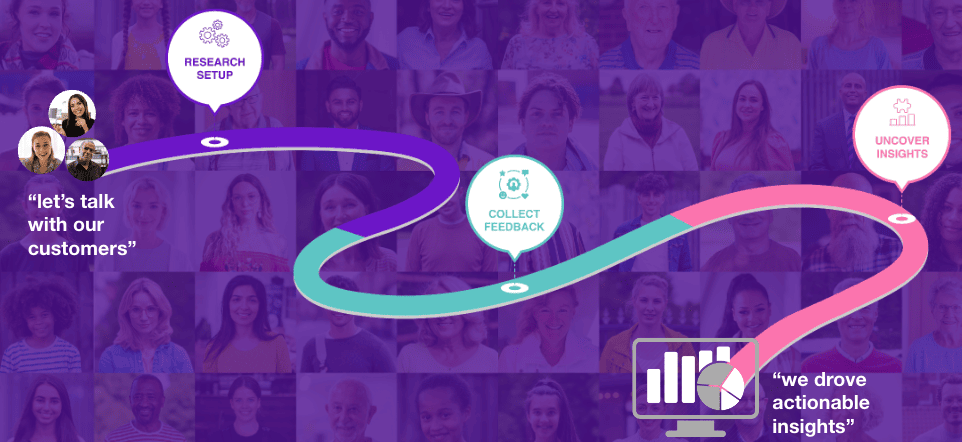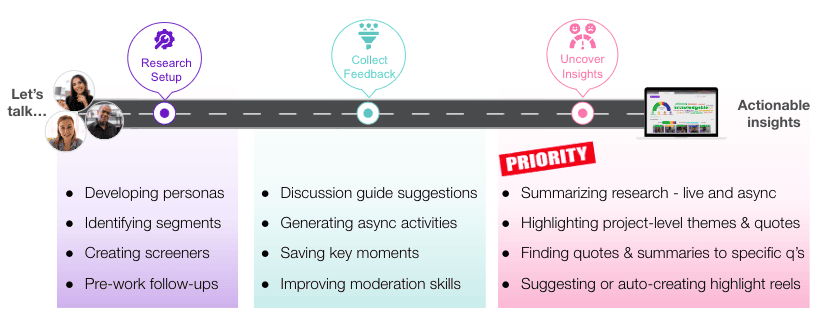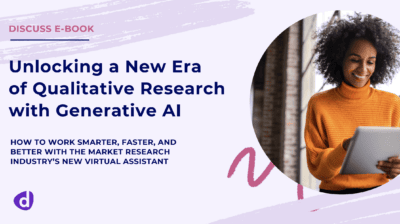Generative AI – Market Research Angel or Devil? How to ensure you win in this new era


There are many questions about this new world:
- What areas of market research will be most impacted?
- What will the positive impacts be on market research?
- What will be the negative impacts?
- What actions can I take and where should I focus if I want to start embracing generative AI?
This post is the first in a series focused on delving into these questions, as it’s no longer up for debate as to whether generative AI is going to be part of the market research world.
But first, let’s define generative AI to avoid any confusion. Forrester defines generative AI (per Rowan Curran, Forrester Analyst focused on Generative AI) as:
A set of technologies and techniques that leverage massive corpuses of data, including large language models, to generate new content (e.g., text, video, images, audio, code, etc.). Inputs may be natural language prompts or other non-code and non-traditional inputs.
Rowan Curran, Forrester
So essentially, it’s lots of data going into an engine, with the engine using that information, along with potential information from other sources, to generate or create something that’s net new.
In the spirit of that definition let’s look at this first question:
What areas of market research will be most impacted by Generative AI?

The above picture highlights the 3 main buckets, at least from a researcher’s perspective, where generative AI could have an impact. However, there’s also the perspective of the respondent and how generative AI is now being used, unfortunately often fraudulently, by respondents in quantitative research (e.g., to complete surveys) or qualitative research (responding in bulletin boards).
To give an idea of what market researchers now have to think about in terms of this fraudulent respondent activity in quantitative surveys, take a listen to this 1-minute video where Lenny Murphy, Chief Advisor for Insights and Development at Greenbook, discusses his own experience in analyzing surveys that were completed for the 2023 annual industry GRIT report:
“From a sample size of 2,700, over 600 responses were fake…I’m hearing numbers as high as 70% of sample being thrown away because they’re not authentic, real responses, and I would argue that is a crisis.”
Lenny Murphy, Greenbook
We’ll pick back up on this potential crisis that’s brewing in quantitative research in this new era of generative AI in the next blog in our generative AI series, but for now we’re going to focus on the potential impact on the qualitative side. As market research and consumer insights teams try to move as fast as possible from the point they want to start talking to customers to when they finish the summary report, generative AI will ultimately offer many possibilities to turn this winding road to insights into a freeway. Here are just a few example applications of where generative AI will provide transformative value and save dozens of hours of work in every project while helping to produce a higher quality end report full of the most critical insights.

From the many conversations I’ve been in over the past 9 months, the area of highest potential impact and priority is on helping analyze responses. And this makes sense, because when all of the interviews are completed in a qualitative research project, what’s left is a mountain of unstructured data. Just consider the following scenario of a typical qualitative research project:
- 7 in-depth interviews conducted
- 3 focus groups were conducted, each with 4 respondents
In this example, without the help of technology, the person analyzing the responses will likely need to review 10+ hours of video, in addition to reading through transcripts, all while making notes, creating a summary report, and determining what the key insights themes should be called out and highlighted within their report. With technology and tools like Discuss, even prior to generative AI coming into the picture, this time to create final summary reports can be dramatically decreased through a variety of capabilities – e.g., the ‘Save Moment’ button allows for any observer or moderator to save key statements made in a click and bookmark their location in the recording, the highlight reels capabilities allow for easily connecting key moments into short, bite-sized videos that can then be easily shared, etc.
But, most importantly:
How could generative AI help in analyzing responses for this project that includes multiple live, moderated interview sessions?
If you think about it, the challenge that sits in front of the researcher analyzing sessions is that they essentially have a mountain of unstructured data. Unlike quantitative studies where you can easily use a variety of reporting and data visualization tools (often built into the quant tools themselves) to synthesize target audience responses, qualitative research has not had something analogous to helping turn those perspectives into actionable insights.
Generative AI is the paradigm shift for analyzing unstructured data. Going back to our definition from earlier, generative AI can literally create something new – in this case a recap of the interview or summary across all or a portion of the interviews in a project. Imagine being able to instantly have summaries created where key themes are highlighted. Generative AI makes that possible. Now exactly how that summary is created, how accurate it is, and how quickly and seamlessly it’s viewable does rely on:
- Using technology that is set up to feed that data into an engine automatically.
- The quality of the transcription technology being used so as to correctly identify what is being said – accent comprehension, identification of proper names, and delineating who is speaking (moderator, focus group respondent 1/2/3) are all things that can throw off recaps and summaries unless it’s best-in-class.
- Properly crafting the right prompts for the engine, might seem like an easy thing but I can tell you after seeing our team refine and refine and refine our prompts over many months to ensure that summaries get to the level of detail needed, it is not a simple task.
Ultimately, the way I believe generative AI should be viewed is as a virtual assistant. Are these summary reports that will be created ready to be the ‘final’ reports for the project? No. But can they save hours in transcript review and act as another check for those who create the reports? Yes.
At the end of the day, for anyone in market research, the words of advice I would give as it pertains to generative AI are:
Generative AI is not going to take your job – someone who is willing to embrace and work with generative AI better or more than you will.
So start small, think about where you want to focus your generative AI efforts, and prioritize where you think you and your organization will receive the most value.
In my next post in this series, we’ll dive into the aspects of security in using generative AI that ensures compliance to global privacy regulations as well as your own information security team’s guidelines for ensuring respondent and organizational data remains secure and private.
About Adam Mertz:
Adam is responsible for leading the innovation, go-to-market, and growth strategies for Discuss. His past 2+ years with Discuss have been focused on driving a culture of obsessing over customer challenges in market research, and innovation that enables customers to rethink what’s possible in scaling qual research. Adam frequently speaks on the new era market research is now in. Recently, he has moderated a thought leader panel on the use of generative AI in in market research, How to Change the Game With Generative AI in Market Research, which featured Rowan Curran, Forrester analyst focused on generative AI, Robin Lindberg, Principal at Quadrant Strategies, Liz White, SVP of Research and Strategy at Buzzback; as well as his upcoming session at TMRE’s annual conference with Sai Pisipati, Consumer Insights and Analytics Manager at Reckitt, Scaling Global Empathy – What’s Worked and How Gen AI Changes the Game.
Sign Up for our Newsletter
Related Articles

Part 3: Generative AI – Market Research Angel or Devil? How to ensure you win in this new era
By Adam Mertz, Chief Growth Officer at Discuss In part one of this blog series I spent time reviewing the…
By Adam Mertz, Chief Growth Officer at Discuss In part one of this blog series I spent time reviewing the…

Part 2: Generative AI – Market Research Angel or Devil? How to ensure you win in this new era
By Adam Mertz, Chief Growth Officer at Discuss In part 1 of this blog series, I focused on a lot…
By Adam Mertz, Chief Growth Officer at Discuss In part 1 of this blog series, I focused on a lot…

Forrester and G2 Reports Explained
In this short video, Discuss’ Chief Growth Officer, Adam Mertz, highlights three recent industry reports and their implications for choosing…
In this short video, Discuss’ Chief Growth Officer, Adam Mertz, highlights three recent industry reports and their implications for choosing…



